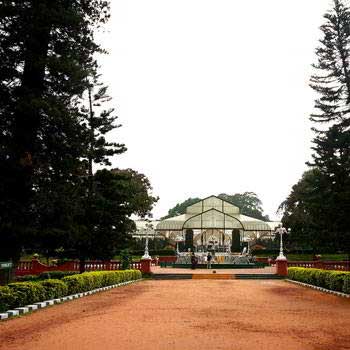Explore Lal Bagh Botanical Garden: A Horticultural Marvel in Bangalore

Covering 240 acres, Lal Bagh Garden in South Bangalore serves as a hub for plant study, conservation, and botanical art.
As the home to thousands of diverse plant species, this tranquil garden boasts historical ties to Hyder Ali and Tipu Sultan, featuring an assortment of plants from Afghanistan, Persia, and France within the Government Botanical Garden.
A highlight of the garden is a remarkable 3,000-million-year-old rock. Previously known as the Cypress Garden or Rose Garden, Lal Bagh has evolved significantly over time.
The horticultural expertise of Hyder Ali’s father laid a solid foundation, subsequently enriched by Tipu Sultan's introduction of numerous exotic plants, thus transforming Lal Bagh into a key attraction in Bangalore.
Continuous enhancements and the introduction of new plant species are notable aspects of the garden's evolution. Photographers often find inspiration in the blooms of species such as Cymbidium, Touch-me-not (Impatiens), Fuchsia, and Begonia.
The garden also features Bonsai cultivation, mushroom farming, horticulture training, Ikebana classes, and post-harvest technology instruction.
Specialty:
The annual flower show at the esteemed Glass House, which also encompasses an aquarium and lake, is a major event.
Bird enthusiasts can spot species like the Pond Heron, Common Egret, Brahminy Kite, and Purple Moorhen.
The garden’s advanced irrigation system efficiently waters over 1,000 species of plants.
Access is facilitated through four distinct gateways: the Northern Gate leading to the Glass House, the main Southern Gate, the Eastern Gate near Jayanagar, and the Western Gate close to Siddapura Circle.
The garden boasts approximately 1,854 plant species from locales such as Cape Town, Kabul, Mauritius, and Turkey.
Significant attractions include the carbonized remains of a 20-million-year-old coniferous tree, the Deer Paddock, a lecture hall for horticulture lessons, Lal Bagh House, the Directorate Building, Pigeon House, Museum, and a statue of Chamaraja Woodeyar.
The flower shows during Independence Day and Republic Day draw massive crowds, captivated by the exquisite floral displays.
Flowers artistically arranged to resemble butterflies offer a breathtaking spectacle.
John Cameron's redesign of the Glass House post-1898 was inspired by London’s Crystal Palace.
Nearest Tourist Attractions:
Sri Chamarajendra Park: Often referred to as the “lung area” of Bangalore, this park highlights the city’s verdant nature. Just 2.4 km away.
Gallery Manora: This gallery allows visitors to explore diverse artistic expressions and textile designs. Located 8.3 km away.
Shivoham Shiva Temple: Features a 65-foot statue of Lord Shiva, meticulously maintained and regularly hosting Aarti and mantra chanting for Lord Ganesha. Approximately 9.3 km away.
Halasuru Someshwara Temple: A treasure trove of intricate sculptures from the Hoysala period depicting mythical and religious themes. Situated 5.9 km away.
Activities:
Explore Historical Landmarks
Relax by the Lake
Shop for Fresh Produce
Photography
Birdwatching
Enjoy Local Cuisine
Best Time to Visit:
Ideal visitation times are between November and February, with moderate temperatures and vibrant flower shows in January and August. Bangalore’s climate is generally mild year-round, making it a favorable destination any time.
Way to Reach:
By Air: Kempe Gowda International Airport links Bangalore with over 50 domestic destinations. It is 37.4 km from the city center.
By Rail: Bangalore features two main terminals: Bangalore City, at the heart of the city, and Yeshwantpur Junction, which accommodates long-distance trains.
By Road: Connections via public and private buses from cities like Goa, Mumbai, Hyderabad, and Chennai are readily available.
Local Transport: Options include the Bangalore Metropolitan Transport Corporation, Volvo buses, the Bangalore Airport Bus Service, three-wheeled auto rickshaws, and the Metro. Services operate from 5 am to 11 pm.
FAQ:
What are the highlights of Lal Bagh Botanical Garden?
Lal Bagh is renowned for its vast collection of over 1,854 plant species, including exotic varieties from Afghanistan, Persia, and France. It features a 3,000-million-year-old rock, bonsai gardens, and hosts annual flower shows at the Glass House.
When is the best time to visit Lal Bagh Botanical Garden?
The ideal times to visit are from November to February when the weather is pleasant, and the garden hosts vibrant flower shows in January and August. Bangalore’s mild climate makes it a year-round destination for nature enthusiasts.
What activities can I enjoy at Lal Bagh Botanical Garden?
Visitors can engage in photography sessions amidst diverse flora, participate in birdwatching to spot species like Pond Heron and Brahminy Kite, explore historical landmarks within the garden, and attend cultural events such as Ikebana classes.
How do I reach Lal Bagh Botanical Garden?
Lal Bagh is conveniently accessible by air via Kempe Gowda International Airport (37.4 km), by rail from Bangalore City and Yeshwantpur Junction, and by road with frequent bus services connecting major cities like Goa, Mumbai, Hyderabad, and Chennai.
What are the nearby attractions to Lal Bagh Botanical Garden?
Nearby attractions include Sri Chamarajendra Park, known for its green spaces, Halasuru Someshwara Temple with its intricate Hoysala sculptures, and Gallery Manora showcasing diverse artistic expressions—all offering enriching experiences near Lal Bagh.